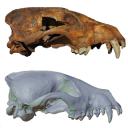















| Plane | Position | Flip |
| Show planes | Show edges |
0.0
M3#1475
Holotype of Speothos pacivorus
Data citation:
Juan V. Ruiz , Christina Kyriakouli
, Kasper Hansen
, Carsten Gundlach
, Gabriel S. Ferreira
, Fabio A. Machado
, Pedro L. Godoy
, Mariela C. Castro
and Felipe C. Montefeltro
, 2024. M3#1475. doi: 10.18563/m3.sf.1475
Model solid/transparent

|
The Fossils of Speothos pacivorus (Carnivora: Canidae) at the Peter Lund/Quaternary Collection of the Natural History Museum of DenmarkJuan V. Ruiz, Christina Kyriakouli, Kasper Hansen, Carsten Gundlach, Gabriel S. Ferreira, Fabio A. Machado, Pedro L. Godoy, Mariela C. Castro and Felipe C. MontefeltroPublished online: 14/05/2024Keywords: 3D reconstruction; Canidae; Lagoa Santa Karst; Pleistocene; Speothos https://doi.org/10.18563/journal.m3.229 Abstract Speothos pacivorus is an extinct South American canid (Canidae: Cerdocyonina) from the Pleistocene of Lagoa Santa Karst, Central Brazil. This taxon is one of the hypercarnivore canids that vanished from the continent at the end of Pleistocene. Although all remains of Speothos pacivorus were collected in the 19th century by the Danish naturalist Peter W. Lund, few studies have committed to an in-depth analysis of the taxon and the known specimens. Here, we analyzed all biological remains of S. pacivorus hosted in the Peter Lund/Quaternary Collection at the Natural History Museum of Denmark, Copenhagen, by listing and illustrating all its specimens known to date. We also conducted a reconstruction of the holotype, an almost complete cranium, based on a µCT scan, producing an undeformed and crack-free three-dimensional model. With this data available we aim to foster new research on this elusive species. M3 article infos Published in Volume 10, issue 02 (2024) |
|